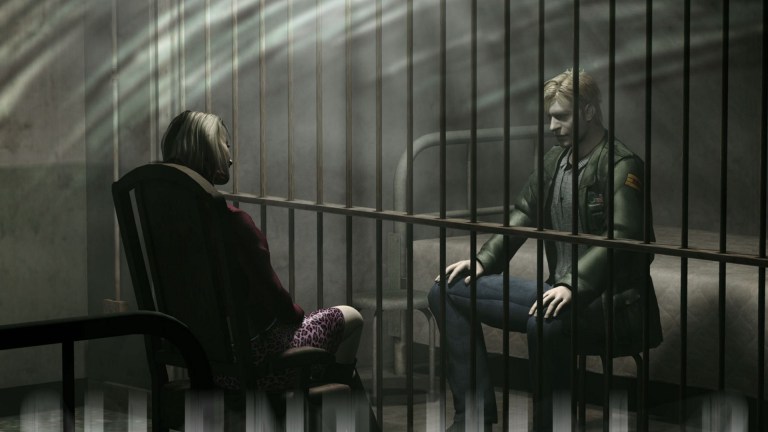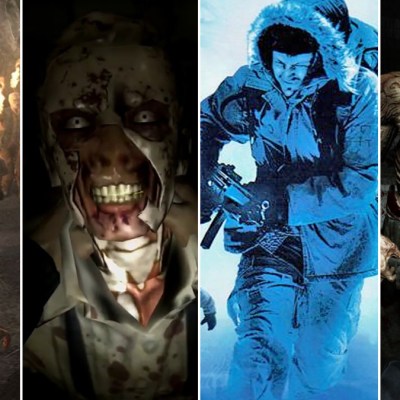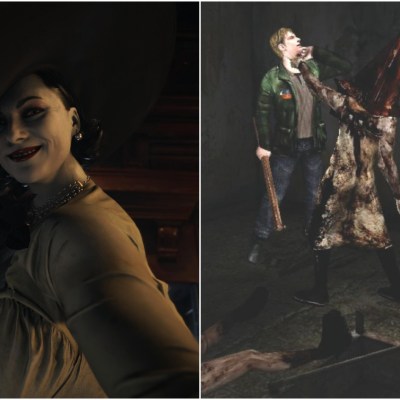Does Silent Hill 2 Have a True Ending?
Silent Hill 2 fans have spent the last 20 years debating which of the game's six endings fit best into the franchise's canon.

Silent Hill 2’s legacy has only grown in the 20 years since its release. While Konami’s follow-up to one of the best horror games of the PS1 era was a critical hit out of the gate, it’s taken years for people to fully grasp the brilliance of Silent Hill 2’s atmosphere, characters, and story.
Silent Hill 2 casts players in the role of James Sunderland: a mysterious man who receives a letter from his deceased wife that asks him to come and find her in the town of Silent Hill. What follows is a haunting trip through the town itself that eventually leads us to one of the most shocking revelations in video game history: most of Silent Hill’s horrors are manifestations of James’ psyche born from his guilt over killing his sick wife.
How that story ends is really up to the player. There are six endings in Silent Hill 2, and which one you see is determined by your actions in the game and how they supposedly reflect James’ mentality. It’s a brilliant storytelling device that not only intelligently weaves the title’s gameplay into the narrative but suggests that players ultimately receive the ending they “deserve” based on their actions.
However, fans have often wondered whether or not Silent Hill 2 has a “canonical” ending. While it’s fantastic that the game is open to so many interpretations, the fact that Silent Hill 2 is also the second entry in a beloved horror franchise has triggered a 20-year debate over which of the game’s six conclusions truly belong to the canon.
Officially, Silent Hill 2 has no canonical ending. Writer Hiroyuki Owaku and other members of the team have either not answered questions regarding SIlent Hill 2’s canonical conclusion, or they’ve “dodged” the question by suggesting the canonical ending is the one you see.
Yet, a closer look at Silent Hill 2’s various finales reveals that the debate over the game’s canonical ending is less about needing a definitive answer to this question and is more about celebrating the various ways that so many of these endings offer distinctly different, yet equally satisfying, possible answers to the question “What became of James Sunderland?”
Silent Hill 2’s “Dog” and “UFO” Endings Are Just Fun Jokes
Silent Hill 2’s two “joke” endings are pretty easy to dismiss in any discussion of possible canonical conclusions.
The “Dog” ending suggests that a dog has been controlling pretty much everything that happens to James in Silent Hill 2, while the UFO ending sees James abducted by aliens (with help from the original Silent Hill’s protagonist, Harry Mason). They’re really little more than Easter eggs meant to reward extremely dedicated players.
Granted, a UFO ending was also featured in the original Silent Hill, but given that this ending wasn’t even added to the sequel until subsequent ports and re-releases, there’s really no way it should be considered anything but a gag.
Silent Hill 2’s “Rebirth” Ending Offers a Haunting Possibility Straight Out of a Stephen King Novel
Silent Hill 2’s “Rebirth” ending sees James kill the mutated form of his wife Mary and then take Mary’s body to the Church of Rebirth at the center of a lake. This ending is triggered by beating the game once and finding four special items during your next playthrough.
The ending itself is narratively fascinating. On a very basic level, it suggests that the items James found convinced him that it’s possible to bring his wife back to life. Given how resurrection typically works in horror (and considering that one of the books James finds as part of this ending bears a striking resemblance to Pet Semetary’s lore), we can only assume that this resurrection went terribly wrong (if it worked at all).
However, the bigger takeaway from this ending has less to do with the idea that James might actually resurrect Mary and more to do with the idea that James himself has essentially succumbed to madness. Whether or not Mary is brought back to life and whether or not James finds his way back from the church is seemingly less important than the idea that James’ decision to go to the church in the first place means he is lost and hasn’t really learned the right lessons from his time in the town.
So far as the canon goes, “Rebirth” is kind of a tough sell. Silent Hill’s “original” three endings (the ones you can see during your first playthrough) are all based on the player’s gameplay actions and what they tell us about James’ psyche. From that standpoint, it’s difficult to say what the idea of “beating” the game is supposed to represent and what the narrative explanation for these new items being added to the game during a second playthrough really is.
While some games hide their “true” or complete endings behind requirements such as beating the game once, this particular conclusion feels closer to a “What if?” scenario designed to be seen by dedicated fans rather than the ending you’re necessarily meant to find in order to see how the game really ends.
Silent Hill 2’s “Maria” Ending Offers the Game’s Most Ambiguous Conclusion
Silent Hill 2’s “Maria” ending is the first of the endings we’ll talk about that can actually be seen during your initial playthrough. It’s also one of the game’s strangest and most complicated conclusions.
To see Silent Hill 2’s “Maria” ending, you have to be very nice to Maria (a character you find in the town who looks a lot like James’ wife and even has some of her memories) throughout the game. Along with performing specific actions at specific times (such as visiting Maria in the hospital as many times as possible) you also have to make sure that you don’t lead Maria astray for long or allow her to take excessive damage.
Do everything right, and your “reward” is an ending that sees James and Maria meet after the final boss battle. Maria gives James a letter from Mary in which Mary essentially acknowledges how her illness has damaged their relationship and expresses her complex feeling regarding that fracture. James and Maria then decide to leave the town together, but Maria starts coughing in a way that strongly suggests that she has the same disease that Mary had when she died.
This is…a weird one. The simplest read suggests that the player’s actions towards Maria are intended to convey James’ growing feelings (obsession?) towards her and that this ending shows that the two finally get together. The cough could be interpreted as a bad thing (James has to watch someone he loves suffer again and may end up killing her), but maybe this is actually James getting a second chance to do the right thing and find redemption and forgiveness for himself by better handling this hardship.
However, that theory is complicated by the fact it’s strongly suggested Maria isn’t actually “real” and is instead a manifestation of James’ conscious (like so many other things in the town). That interpretation is admittedly further complicated by the game’s supplementary “Born From A Wish” chapter which shows Maria on her own adventure without James, but there is still enough evidence to support the general idea that the Maria we know is not just an entirely “normal” person in the physical sense.
As such, it seems more likely that this ending is indeed meant to convey how James has not moved on from what happened to Mary and will continue to punish himself by either going through it yet again or leaving with the knowledge he will never, could never, and perhaps should never forgive himself for what he did. That interpretation is supported by Maria’s generally villainous nature and the idea that she, in some way, is less of a version of Mary waiting to be saved and more of a representation of James’ guilt over Mary’s death combined with his repressed sexual urges that make her more symbolic of James’ desire for Mary as he wants to remember her rather than the person she necessarily was (especially at the end).
This ending does fit the grander ideas of Silent Hill 2’s narrative and gameplay/storytelling relationship, so it’s not quite as easy to dismiss it outright like we can with the other conclusions we’ve discussed so far. At the same time, this ending’s incredibly ambiguous nature (from both a thematic and narrative standpoint) raises serious questions and what happens next and how our perception of those events is intended to affect our perception of future Silent Hill games.
While that ambiguity makes this one of the game’s most memorable endings (and the ending itself is a satisfying overall conclusion to the game in a lot of ways), it is interesting to see how the next two finales offer something that feels slightly more definitive.
Silent Hill 2’s “Leave” Ending Is The Closest This Game Comes to a Traditional Happy Ending
Silent Hill 2’s “Leave” ending can be seen by doing all you can to demonstrate a will to live and desire to come to terms with what James did. That means you have to keep your health high, avoid becoming obsessed with Maria, and take time to pay Mary the proper respect through acknowledging her pain as well as your own.
If you make the right decisions, you’ll eventually encounter a figure you believe to be Mary who is actually Maria. Soon thereafter, Maria literally turns into a monster who James must kill. After doing so, James “meets” Mary again and the two have a pretty nuanced conversation about what James did and whether or not he should continue to live his life burdened by the incredible guilt of it. We then cut to a cemetery, listen to Mary narrate the letter she left James, and watch as James and Laura (a girl he met in Silent Hill) walk through a cemetery.
For all intents and purposes, this is Silent Hill 2’s “good” ending, which is noteworthy not only because it’s the game’s only clear good ending (depending on your interpretations) but because other Silent Hill game’s “canonical” endings are typically variations of their good endings.
It’s also very much worth noting that there are hints throughout Silent Hill 2 that suggest James is not somehow “doomed” to be punished for the rest of his life. Indeed, there are multiple points in the game where it’s strongly implied that James is indeed seeking redemption and can achieve it if he is able to find a way to forgive himself while still demonstrating atonement and a will to live. Well, that’s what the player must do to trigger this ending.
The Laura factor is also interesting. A popular theory suggests that Laura is one of the only “real” people in Silent Hill 2 and that she doesn’t view the town as a punishment. Indeed, it’s implied that she doesn’t see any of the horrors in the town and may instead see it as a joyful, rewarding place. If Laura is a manifestation of James’ psyche, then it’s strongly implied that she could be seen as the daughter that he and Mary never had. In either case, Laura seems to represent innocence, possibilities, and the start of something new.
Furthermore, it’s been said that Elee from Silent Hill: Homecoming was originally supposed to be an older version of Laura who was going to wear James’ jacket. That would tend to suggest that the Homecoming team may have considered building upon the ending in which Laura and James escaped (though that isn’t the only possibility that would help explain how Laura got the jacket).
Speaking of sequels, it should also be noted that Silent Hill 4 features a brief scene with Frank Sunderland (James’ father) who says that his son “disappeared in Silent Hill a few years back.” While it’s possible that James never went to see his dad again following the events of Silent Hill 2, a more popular interpretation of that statement suggests that James simply never made it out of the town. That brings us to the game’s final ending…
Silent Hill 2’s “In Water” Ending is The Most Commonly Accepted Canonical Conclusion
Silent Hill 2’s In Water ending is reserved for players who quite simply demonstrate self-destructive tendencies. If you don’t try to heal yourself quickly, consistently take massive amounts of damage, and generally fail to exhibit the desire to achieve forgiveness, then you’ll be “treated” to a haunting ending in which James essentially remembers that he came to Silent Hill to kill himself. He then drowns himself in the lake in the hopes of rejoining his wife in the afterlife.
Let’s not beat around the bush: there are numerous pieces of evidence that suggest this is the strongest contender for Silent Hill 2’s “canonical ending.” Here are just a few:
- The novelization of Silent Hill 2 uses the “In Water” ending (though there is some debate regarding how much the author knew about the project’s development and what Silent Hill 2‘s writers intended).
- “In Water” is the only ending that features a shot of James carrying Mary that is prominently featured in Silent Hill 2’s instruction manual and promo art.
- Members of the Silent Hill 2 team (including designer Masahiro Ito and James’ voice actor Guy Chi) have previously indicated that they view this as the true (or at least their prefered) ending.
- Pyramid Head was reportedly designed with the context of the “In Water” ending in mind.
- Water is featured prominently throughout the game as both a form of punishment and escape/”redemption.”
- It’s been suggested that James’ took Mary’s body to Silent Hill with him and intended to commit the act of Shinjū (a ritualistic form of double suicide).
- This ending explains why James’ father says he never returned from Silent Hill.
- This is the ending that many players see their first time playing the game and is therefore the ending that many people associate with the game if they didn’t intentionally try to acquire additional/alternative endings.
Put it all together, and you really start to see why so many people have suggested that “In Water” is the most logical Silent Hill 2 ending even if it isn’t necessarily the ending that has been officially adopted as canonical. Nearly everything about it from a narrative and thematic standpoint mesh with the events of the game, Harry’s psychological state, and what few direct connections Silent Hill 2 has to the rest of the series.
Furthermore, there is evidence that suggests the team didn’t necessarily see this as an entirely sad ending. That’s a very fine line to walk given that I do not want to glorify James’ decision to kill himself, but what we know about the creative motivation behind this ending strongly implies that this idea was based less on the belief that the town defeated James and more on the thought that this was simply a fitting conclusion to what James had just gone through.
At the same time, I do find it interesting that it’s suggested James drove to Silent Hill to commit suicide but James actually says during the game that he doesn’t believe in suicide. He could have been lying, forgot why he came, or simply changed his mind due to his experiences/mental state, but it is one of those factors that complicates the idea that this ending offers a clean explanation for everything that happens before.
Which Silent Hill 2 Ending is Canonical?
If it comes down to it, I would also have to agree that “In Water” feels like Silent Hill 2’s most appropriate, complete, and overall fascinating ending. If you were going to make an argument for which ending fits into the canon most cleanly, that and “Leave” would probably be the easiest to support.
At the same time, it’s very much worth emphasizing that the game’s lack of a canonical ending in the traditional sense of the term has always been intentional. Most of Silent Hill 2’s endings are based on the choices you make as James and how those choices supposedly represent your own psychology as well as your character’s psychology. While the unique post-game nature of the Dog/UFO and “Rebirth” endings arguably make them harder to accept as canonical for that reason, “In Water,” “Maria,” and “Leave” all offer fascinating interpretations of what happens to James based on your actions and decisions.
Of course, it is also interesting to think that so many people seem to remember getting the “In Water” ending the first time they played the game. While that probably has something to do with how closely that ending is related to taking damage and performing more obvious actions (things that you can expect to happen in survival horror games) maybe the fact that “In Water” seems to be one of the easiest endings to “accidentally” get tells us something about how the developers suspected our Silent Hill 2 journey would end.


